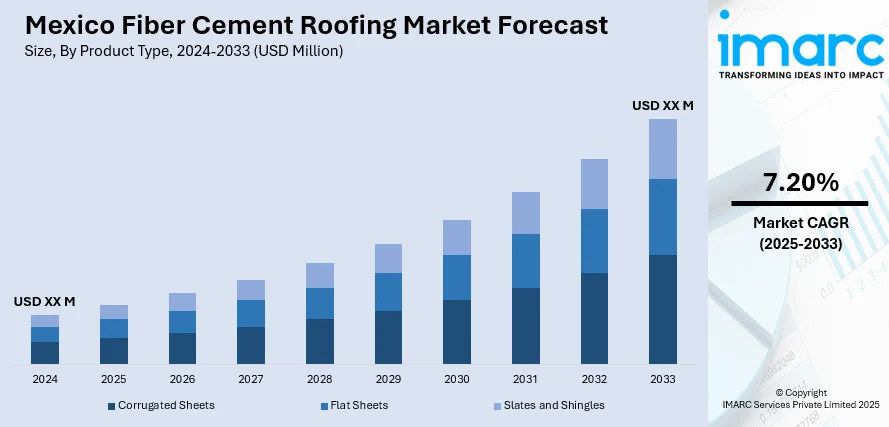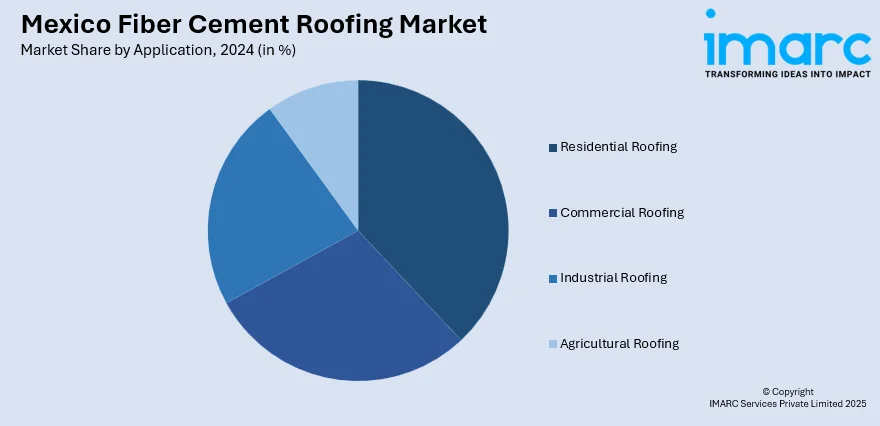
Mexico Fiber Cement Roofing Market Size, Share, Trends and Forecast by Product Type, Material Composition, Application, End Use Sector, and Region, 2025-2033
Mexico Fiber Cement Roofing Market Overview:
The Mexico fiber cement roofing market size is projected to exhibit a growth rate (CAGR) of 7.20% during 2025-2033. The market is majorly driven by the growing demand for durable, weather-resistant roofing that is suitable for Mexico’s varied climate conditions. Rapid urbanization and considerable expansion in residential construction activities are also fueling the adoption of cost-effective, lightweight fiber cement roofing systems. Environmental regulations and sustainability initiatives are promoting the usage of eco-friendly materials with energy-efficient benefits, further augmenting the Mexico fiber cement roofing market share.
|
Report Attribute
|
Key Statistics
|
|---|---|
|
Base Year
|
2024
|
|
Forecast Years
|
2025-2033
|
|
Historical Years
|
2019-2024
|
| Market Growth Rate 2025-2033 | 7.20% |
Mexico Fiber Cement Roofing Market Trends:
Increasing Demand for Durable and Weather-Resistant Roofing Solutions
Mexico’s climate, characterized by high temperatures, heavy rains, and occasional hurricanes, drives the demand for roofing materials that offer superior durability and weather resistance. Fiber cement roofing is favored for its ability to withstand extreme weather conditions, including fire resistance, impact tolerance, and protection against moisture infiltration. The material’s robustness ensures long-term performance with minimal maintenance, addressing common roofing challenges in both residential and commercial buildings. Additionally, fiber cement products offer resistance to termites and other pests, a significant advantage in tropical and subtropical regions of Mexico. In a 2024 Mexicali-based study, fiber cement board (THK) walls reduced embodied carbon by 58–77% and energy consumption by 18–19% when paired with various insulated roofs. The best performance was achieved with a concrete slab roof and 1" insulation, offering the highest sustainability gains. Builders and homeowners are increasingly aware of the lifecycle cost benefits fiber cement roofing provides compared to traditional materials such as clay tiles or asphalt shingles. These factors are supported by government building codes and construction standards emphasizing safety and durability, especially in disaster-prone areas. Consequently, the superior protective qualities and longevity of fiber cement roofing are key contributors to Mexico fiber cement roofing market growth, meeting both regulatory requirements and consumer preferences.

Environmental Concerns and Government Regulations
Environmental awareness and sustainability goals are increasingly influencing the construction sector in Mexico, encouraging the use of eco-friendly building materials. In Oaxaca, Mexico, an eco-friendly house prototype (MHTITCA) using a soil–sawdust–cement mix and 2.5 cm exterior polystyrene insulation achieved 85% thermal comfort, 0% overheating, and a 12-hour thermal time lag. It showed a decrement factor of 0.109, thermal conductivity of 0.28 W/m·K, and thermal diffusivity of 1.098 × 10⁻⁶ m²/s, outperforming traditional systems. These results highlight its effectiveness in temperate regions with high thermal fluctuations. Government initiatives promoting sustainable construction practices and energy-efficient buildings are fostering demand for fiber cement products that provide thermal insulation, reducing energy consumption for cooling in hot climates. Fiber cement roofing is considered a greener alternative due to its composition of natural materials and recyclability, with a relatively low carbon footprint compared to traditional roofing options. Mexico’s National Housing Commission (CONAVI) and other regulatory bodies advocate for building materials that contribute to green certifications and compliance with environmental standards. This regulatory framework, combined with growing consumer preference for sustainable housing solutions, supports fiber cement roofing as a material that aligns with long-term environmental objectives. The commitment to sustainability within construction projects is an important driver sustaining market growth by advancing green building practices and material innovation.
Mexico Fiber Cement Roofing Market Segmentation:
IMARC Group provides an analysis of the key trends in each segment of the market, along with forecasts at the country and regional levels for 2025-2033. Our report has categorized the market based on product type, material composition, application, and end use sector.
Product Type Insights:
- Corrugated Sheets
- Flat Sheets
- Slates and Shingles
The report has provided a detailed breakup and analysis of the market based on the product type. This includes corrugated sheets, flat sheets, and slates and shingles.
Material Composition Insights:
- Asbestos Fiber Cement
- Non-Asbestos Fiber Cement
The report has provided a detailed breakup and analysis of the market based on the material composition. This includes asbestos fiber cement and non-asbestos fiber cement.
Application Insights:

- Residential Roofing
- Commercial Roofing
- Industrial Roofing
- Agricultural Roofing
The report has provided a detailed breakup and analysis of the market based on the application. This includes residential roofing, commercial roofing, industrial roofing, and agricultural roofing.
End Use Sector Insights:
- New Construction
- Replacement and Renovation
The report has provided a detailed breakup and analysis of the market based on the end use sector. This includes new construction and replacement and renovation.
Regional Insights:
- Northern Mexico
- Central Mexico
- Southern Mexico
- Others
The report has also provided a comprehensive analysis of all major regional markets. This includes Northern Mexico, Central Mexico, Southern Mexico, and others.
Competitive Landscape:
The market research report has also provided a comprehensive analysis of the competitive landscape. Competitive analysis such as market structure, key player positioning, top winning strategies, competitive dashboard, and company evaluation quadrant has been covered in the report. Also, detailed profiles of all major companies have been provided.
Mexico Fiber Cement Roofing Market Report Coverage:
| Report Features | Details |
|---|---|
| Base Year of the Analysis | 2024 |
| Historical Period | 2019-2024 |
| Forecast Period | 2025-2033 |
| Units | Million USD |
| Scope of the Report |
Exploration of Historical Trends and Market Outlook, Industry Catalysts and Challenges, Segment-Wise Historical and Future Market Assessment:
|
| Product Types Covered | Corrugated Sheets, Flat Sheets, Slates and Shingles |
| Material Compositions Covered | Asbestos Fiber Cement, Non-Asbestos Fiber Cement |
| Applications Covered | Residential Roofing, Commercial Roofing, Industrial Roofing, Agricultural Roofing |
| End Use Sectors Covered | New Construction, Replacement and Renovation |
| Regions Covered | Northern Mexico, Central Mexico, Southern Mexico, Others |
| Customization Scope | 10% Free Customization |
| Post-Sale Analyst Support | 10-12 Weeks |
| Delivery Format | PDF and Excel through Email (We can also provide the editable version of the report in PPT/Word format on special request) |
Key Questions Answered in This Report:
- How has the Mexico fiber cement roofing market performed so far and how will it perform in the coming years?
- What is the breakup of the Mexico fiber cement roofing market on the basis of product type?
- What is the breakup of the Mexico fiber cement roofing market on the basis of material composition?
- What is the breakup of the Mexico fiber cement roofing market on the basis of application?
- What is the breakup of the Mexico fiber cement roofing market on the basis of end use sector?
- What is the breakup of the Mexico fiber cement roofing market on the basis of region?
- What are the various stages in the value chain of the Mexico fiber cement roofing market?
- What are the key driving factors and challenges in the Mexico fiber cement roofing market?
- What is the structure of the Mexico fiber cement roofing market and who are the key players?
- What is the degree of competition in the Mexico fiber cement roofing market?
Key Benefits for Stakeholders:
- IMARC’s industry report offers a comprehensive quantitative analysis of various market segments, historical and current market trends, market forecasts, and dynamics of the Mexico fiber cement roofing market from 2019-2033.
- The research report provides the latest information on the market drivers, challenges, and opportunities in the Mexico fiber cement roofing market.
- Porter's five forces analysis assist stakeholders in assessing the impact of new entrants, competitive rivalry, supplier power, buyer power, and the threat of substitution. It helps stakeholders to analyze the level of competition within the Mexico fiber cement roofing industry and its attractiveness.
- Competitive landscape allows stakeholders to understand their competitive environment and provides an insight into the current positions of key players in the market.
Need more help?
- Speak to our experienced analysts for insights on the current market scenarios.
- Include additional segments and countries to customize the report as per your requirement.
- Gain an unparalleled competitive advantage in your domain by understanding how to utilize the report and positively impacting your operations and revenue.
- For further assistance, please connect with our analysts.
 Request Customization
Request Customization
 Speak to an Analyst
Speak to an Analyst
 Request Brochure
Request Brochure
 Inquire Before Buying
Inquire Before Buying




.webp)




.webp)












